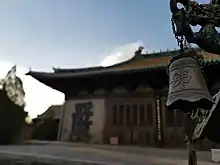Hunyuan County
Hunyuan County is a county under the administration of Datong City, in the northeast of Shanxi province, China.
Hunyuan County
浑源县 Hun-yüan | |
|---|---|
 Hunyuan Location in Shanxi | |
| Coordinates: 39.69°N 113.68°E | |
| Country | People's Republic of China |
| Province | Shanxi |
| Prefecture-level city | Datong |
| Area | |
| • Total | 1,965 km2 (759 sq mi) |
| Population (2010) | 343,486 |
| Time zone | UTC+8 (China Standard) |
| Postal code | 037400 |
| Website | www |
| Hunyuan County | |||||||||||||
|---|---|---|---|---|---|---|---|---|---|---|---|---|---|
 Yong'an Temple, Hunyuan | |||||||||||||
| Simplified Chinese | 浑源县 | ||||||||||||
| Traditional Chinese | 渾源縣 | ||||||||||||
| |||||||||||||
| Guo County | |||||||||||||
| Simplified Chinese | 崞县 | ||||||||||||
| Traditional Chinese | 崞縣 | ||||||||||||
| |||||||||||||
History

During the Spring and Autumn Period of Chinese history, present-day Hunyuan County formed part of the Baidi state of Dai[1][2] to the north of the Zhou Kingdom. It was conquered by the Zhao clan of Jin.
Under the Han, Guo County was established and placed under Yanmen Commandery and Pingshu County was established and placed under Dai Commandery.[3] Pingshu was later merged with Guo County, which was placed in Hengshan Commandery. During the Jianwu Era of the Eastern Han, Guo County was renamed. During the Three Kingdoms, Wei restored the name Guo. This was changed to Guoshan County by the Northern Wei, who placed it under the administration of Si Prefecture.[3] Under the Tang, it was placed in Yun Prefecture.[3]
Landmarks
The 1,500 years old Hanging Temple is an important and unique structure within the Datong area.
Demography
In 2010 the population of the district was 343,486 inhabitants.
See also
References
Citations
- Keller & al. (2007), p. 16.
- Yu (1997), p. 200.
- Shanxi Tourism Bureau (2016), s.v. "Hunyuan County".
Bibliography
- www.xzqh.org (in Chinese)
- "The Origin of the Names of the Counties in Shanxi Province", Official site, Taiyuan: Shanxi Tourism Bureau, 2016.
- Keller, Peter C.; et al. (2007), Treasures from Shanghai: 5,000 Years of Chinese Art and Culture, Santa Ana: Bowers Museum
- Yu Weichao (1997), A Journey into China's Antiquity, Vol. I, Morning Glory Press.